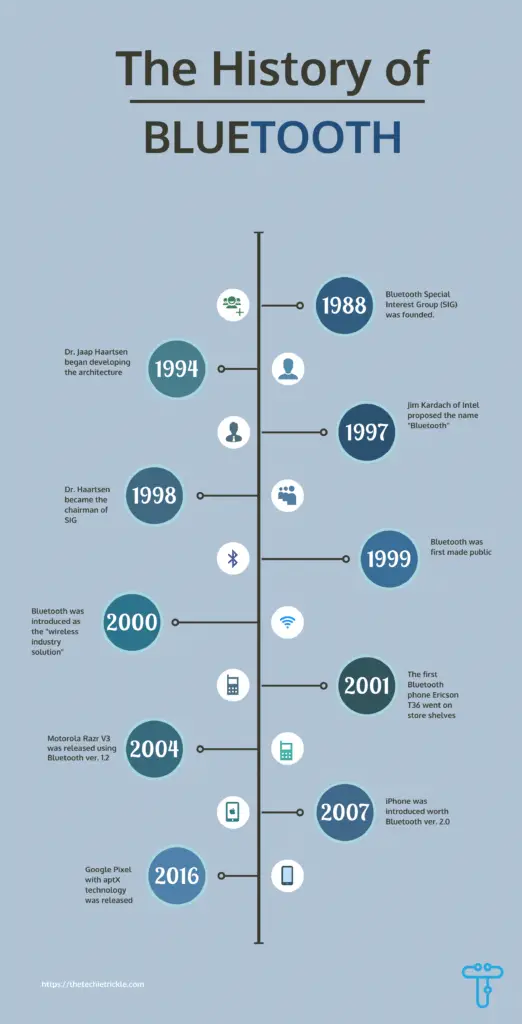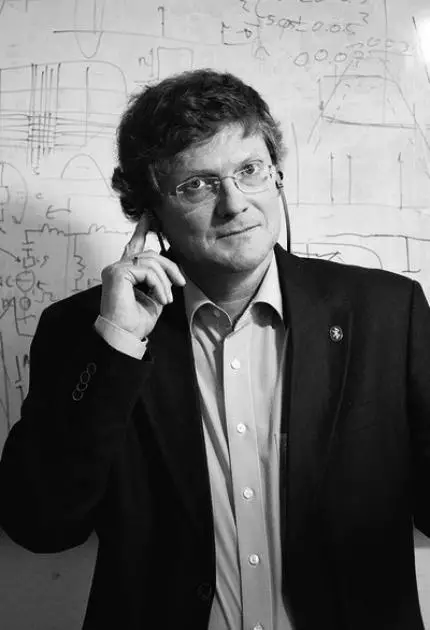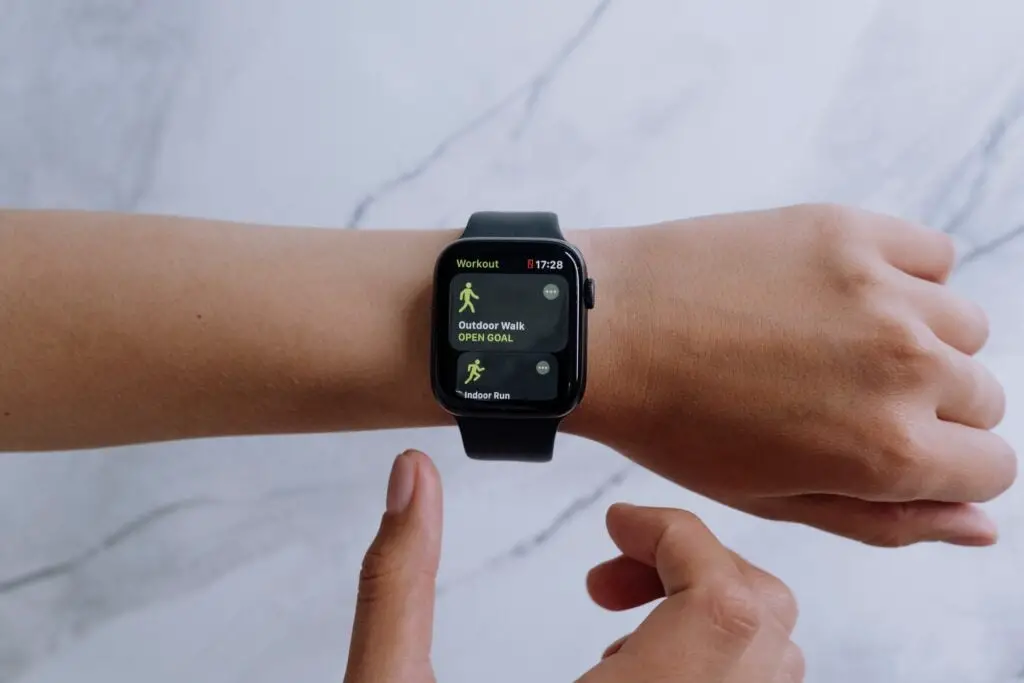Today's post is all about when was Bluetooth invented and the history behind it.
Interested?
Then this article will cover all that information you need to know to get you started with Bluetooth.
Let's begin!
Today's post is all about when was Bluetooth invented and the history behind it.
Interested?
Then this article will cover all that information you need to know to get you started with Bluetooth.
Let's begin!
Share this article:
Share this article:
Bluetooth technology is a short-range wireless communications standard for exchanging data between mobile phones, wireless headphone sets, computers, and other electronic devices.
Let’s take a look at the important milestones in Bluetooth’s history in the infographic below.

Dr. Jaap Haartsen and Sven Mattisson are the two men who invented Bluetooth when they were working at Ericsson in Lund, Sweden, in 1994.

In 1994, Jaap Haartsen began developing the architecture that became known as Bluetooth Wireless Technology, which enabled devices to communicate with one another regardless of the distance between them.
Haartsen was primarily responsible for some critical Bluetooth developments, and he is the only inventor credited on the patent that covers essential Bluetooth communications.
In 1997, Jim Kardach of Intel, one of the founding members of the Bluetooth SIG, proposed the name “Bluetooth.”
The name comes from a discussion with Sven Mattisson.
He compared Scandinavian history to Frans G. Bengtsson’s The Long Ships, a historical novel about Vikings and the 10th-century Danish king Harald Bluetooth.
When creating the Bluetooth standard, the creators believed they were accomplishing something similar in bringing together the PC and cellular industries.
Bluetooth technology was first made publicly available in a series of products released in late 1999 and early 2000.
This range included a headset, the “Ericsson HBH-IS800,” which could be connected to mobile phones using a cable or a wireless link.
In 2000, when Bluetooth was introduced as the “wireless industry solution” for short-range connectivity from mobile phones to headsets and other devices, it had a transfer rate of about 723 Kbit/s.
The Bluetooth logo has a backstory of its own. It comprises the Nordic runes for H and B, which signify King Harald Bluetooth.
Bluetooth was meant for the express purpose of uniting devices in the same way that Harald Bluetooth united Denmark’s tribes into a single kingdom.
Check what they have to say about the Bluetooth symbol.
In 1988, the Bluetooth SIG (Special Interest Group) was founded to promote and publish the standard and subsequent versions. The SIG to this day is in charge of these responsibilities.
The Bluetooth SIG initially included only Ericsson, IBM, Intel, Nokia, and Toshiba, but it had 4,000 members by the end of its first year. The Association has grown to over 30,000 members in a variety of industries.
Between 1998 and 2000, Haartsen became the chairman of the SIG air protocol certifications group, which helped to standardize the Bluetooth radio communications protocol.
The IEEE standardized Bluetooth as IEEE 802.15.1, but it no longer maintains it.
Bluetooth allows two electronic devices within a 10-meter range to connect wirelessly when they are designed to work together.
This way, you can connect your cell phone, computer, or another device that uses Bluetooth technology without having any cords or cables tying you down.
The range of communication between two devices is up to 10 meters depending on the class and environment, and using one is as easy as turning it on.
The beauty of Bluetooth technology is that it allows up to eight devices (such as smartphones or fitness trackers) with the same network protocol, effectively creating an extended ecosystem for you.
To do this, though, your device needs to be paired via short-range radio signals and form part of one single system – which can be a great convenience in certain situations!
Two Bluetooth-enabled devices within ten meters of each other can create an ad-hoc, short-range wireless network called a ‘piconet.’
These pico networks operate in the unlicensed ISM bands ranging from 2.4GHz to 2.485 GHz.
They have been seen as a revolutionary technology due to their ability for small groups or individuals who may not access public Wi-Fi hotspots without it being blocked by someone else using bandwidth too much!
When connected to the same piconet, eight devices can send and receive data, and multiple piconets can operate on one device.
A group of devices connected can act as a single, centralized data hub.
This means that one master device has the power to send information wirelessly while all other involved members are acting only as recipients – usually called slaves or clients in this context!
You can think of a Bluetooth piconet as the perfect tool for efficiently managing your business’s communications needs.
You will be able to send faxes, share files and printers with colleagues or connect multiple devices seamlessly without any interference from other networks – all while operating within short distances!
Bluetooth wireless technology was the first of its kind to be used in wearable devices.
The first Bluetooth smart watches had Bluetooth chips implanted in them to connect to other devices.

This allowed people to sync their watches with phones and computers and receive notifications on their watches.
These Bluetooth chips are typically tiny and can easily be integrated into such devices.
The use of Bluetooth has increased considerably for its unique capabilities.
In 2000, when Bluetooth was introduced as the “wireless industry solution” for short-range connectivity from mobile phones to headsets and other devices, it had a transfer rate of about 723 Kbit/s.
The first Bluetooth phone was the Ericsson T36, which went on store shelves in 2001. However, the updated T39 model became available for sale in stores.
The Ericsson T39 was the first Bluetooth mobile phone, and it was introduced in 2001. It had many features that made it stand out from other phones at the time, such as:
During the early 2000s, many manufacturers released their Bluetooth phones. They were all competing to release the best cellular phone with more features and better capabilities.
The models became more diverse with flip, slide, swivel designs, plus some of them included a full-QWERTY keyboard when opened.
The shape of the phones was designed for comfort when talking, texting, or surfing the internet, while still trying to make them look visually appealing when they are closed.
The Sony Ericsson P800 was one example of this when it came out in 2002.
Many different types of people use phones with Bluetooth capabilities for many different reasons.
Of course, when they first came out, people were using them when transferring data to your computer or when you needed wireless earpieces, but over time their uses became more diverse.
Each evolving phone’s objective was to reduce power consumption by putting the connection into sleep mode as soon as it detected inactivity.
The Nokia 8250 was one of the early models of cell phones that had Bluetooth capabilities.
Released in 2001, it was one of the first phones to have this feature and was a significant game-changer at the time.
The cellular phone had a monochrome LCD display and could flip open to reveal a full-QWERTY keyboard. It also had vibration feedback when you dialed phone numbers.
When it was first introduced, it was having only GSM technology. No Bluetooth features!
The Motorola Razr V3 was one of the most popular cell phones first released in 2004.
It had a sleek and slim design that made it stand out from other models at the time. The phone also had a VGA camera with flash, which was rare for a phone at the time.
One of the main features people loved about the Motorola Razr V3 was it started using Bluetooth version 1.2.
Over time, Bluetooth became more and more common in cell phones when the uses became much different.
Released in 2007, the iPhone was one of the first phones to display a touchscreen. It also had a very sleek and slim design that made it stand out from other models at the time.
The iPhone’s power consumption was much different from the other phones with Bluetooth capabilities when it was first released.
The phone had many features that consumed much power, such as the touchscreen display and the internet connection.
This caused some people to be hesitant about using the iPhone because they were worried about quickly running out of battery.
However, over time, Apple could fix these issues and make the iPhone more efficient when it came to power consumption.
The phone now has a longer battery life and can last for multiple days without charging.
However, what made the iPhone’s Bluetooth capabilities different from other models was that Bluetooth upgraded to version 2.0 and it could also make phone calls when connected to a headset or when in speaker mode.
This was a significant game-changer at the time and changed the way people use Bluetooth technology.
In 2016, the Google Pixel was one of the first phones to have a 5 inch full HD display. It also had a very sleek and slim design that made it stand out from other models at the time.
One of the main features that people loved about the Google Pixel was its Bluetooth capabilities. It was using Bluetooth version 4.2.
However, what made the Google Pixel’s Bluetooth capabilities different from other models was that it had aptX technology which is a cutting-edge technology that allows you to enjoy high quality music over Bluetooth.
It does this by compressing and decompressing audio as it travels from one device, like your phone or speaker wirelessly with no damage of sound being transmitted along for the ride!
Bluetooth stereo headphones hit the market in 2004, but they did not become popular alternatives for traditional wired ones until around 2010.
One of the most popular companies to make Bluetooth stereo headphones in 2011 was Beats by Dre.
The company was founded by Dr. Dre and Jimmy Iovine in 2006 and quickly became a major player in the audio industry. In 2004, it became an Apple subsidiary.
Beats by Dre is known for its high-quality headphones that provide excellent sound quality.
Their headphones are often used by celebrities and athletes when they need to listen to music or take calls on the go.
Over time, Beats by Dre has expanded its product lineup to include earbuds, wireless speaker systems, and car audio systems.
Bluetooth has come a long way since its inception in 1999. The first Bluetooth device was created in that year – a hands-free mobile headset.
Since then, Bluetooth has evolved to version 5.0, the most recent and advanced version.
Since 1999, the Bluetooth specification has changed to make it faster and better. The connection quality has improved, and new features have been added to meet emerging use cases and markets.
Some of the benefits of Bluetooth version 5.0 include faster data transmission, more extended range, and increased capacity.
It is important to note that not all devices are compatible with Bluetooth 5.0 yet. However, as more and more devices adopt this latest version, the benefits will become more and more apparent.
Let us look at the many variations of Bluetooth Wireless Technology and what radio options they provide.
The Bluetooth Official page has two radio options to allow developers greater flexibility in meeting the ever-increasing demand for wireless access.
The Bluetooth Classic radio is also sometimes known as Bluetooth Basic Rate/Enhanced Data Rate (BR/EDR) is mainly used to enable wireless audio streaming and basic data connectivity for mobile devices.
The Bluetooth Low-Energy radio is also sometimes known as Bluetooth LE. Bluetooth Smart is mainly used to enable wireless connectivity of “smart” sensors and beacons to mobile phones, laptops, tablets, and other consumer electronic devices.
This helps to meet the growing need for high-precision indoor location services.
Bluetooth has come a long way since its inception in 1999. The first Bluetooth device was created in that year – a hands-free mobile headset.
Since then, Bluetooth has evolved to version 5.0, the most recent and advanced version.
The connection quality has improved, and new features have been added to meet emerging use cases and markets.
Some of the benefits of Bluetooth 5.0 include faster data transmission, longer range, and increased capacity.
It is important to note that not all electronic gadgets are compatible with Bluetooth 5.0 yet.
However, as more devices start adopting this latest version, it will make for an even better wireless experience when listening to music or talking on your phone!
So let me know which piece of information was interesting to you? Do you have something to share too? Either way I would love to hear back from you.
Latest Posts…

📌 Introduction In the audio world, your equipment can make or break your experience. This is why investing wisely in devices like Bluetooth speakers is vital. One such device that has stirred up conversation recently is the “Bad Alexus Novelty Bluetooth Speaker.”

📌 Introduction Welcome to the ultimate guide to the ceiling fan with Bluetooth speaker. This multi-functional gadget is a game-changer for smart homes. But why exactly should you consider this innovative device? Read on to find answers that will leave you astonished.

📝 Introduction The Bluetooth disco speaker is a quintessential party accessory in a world where everything is wireless. This article is an exhaustive guide to help you understand why these gadgets are game-changers for any dance floor experience.

🌟 Introduction Welcome to this in-depth review of the Vibe Bluetooth Speaker. A harmonious blend of aesthetics and sound, this speaker has become the talk of the town. This article delves deep into the speaker’s key features, helping you decide if it fits your entertainment needs.

📌 Introduction Welcome to the future of construction and fieldwork safety—Bluetooth hard hats. This article aims to delve into the depths of how these modern pieces of safety gear can elevate your on-site productivity while ensuring safety.

📝 Introduction Good earbuds can be a game-changer in our daily routines, whether during workouts, commutes, or simply relaxing at home. But like any tech gadget, sometimes things can go awry. If you’re experiencing issues with your Raycon earbuds, don’t fret! Here’s a comprehensive guide on resetting Raycon earbuds to ensure you always have that […]
27 TOP Differences Between Minecraft: Java Edition and Windows 10 Edition(For NEW Gamers)
5 Longest Running Gacha Games of All Time
7 BEST Ways to Turn On Bluetooth Without a Mouse on Windows 10
All About How to Change Your Xbox Gamertag(5 Easy Steps)
🎵 Ceiling Fan with Bluetooth Speaker: 5 Jaw-Dropping Benefits You Can’t Ignore
5 Best Wireless Earbuds for the Elderly
How to manage Xbox Game Pass subscriptions through the Xbox Companion App?
Master the Art of Gaming: A Beginner’s Guide to Gamers